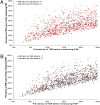HIV, transmitted drug resistance, and the paradox of preexposure prophylaxis
- PMID: 20616092
- PMCID: PMC2901470
- DOI: 10.1073/pnas.1006061107
HIV, transmitted drug resistance, and the paradox of preexposure prophylaxis
Abstract
The administration of antiretrovirals before HIV exposure to prevent infection (i.e., preexposure prophylaxis; PrEP) is under evaluation in clinical trials. Because PrEP is based on antiretrovirals, there is considerable concern that it could substantially increase transmitted resistance, particularly in resource-rich countries. Here we use a mathematical model to predict the effect of PrEP interventions on the HIV epidemic in the men-who-have-sex-with-men community in San Francisco. The model is calibrated using Monte Carlo filtering and analyzed by constructing nonlinear response hypersurfaces. We predict PrEP interventions could substantially reduce transmission but significantly increase the proportion of new infections caused by resistant strains. Two mechanisms can cause this increase. If risk compensation occurs, the proportion increases due to increasing transmission of resistant strains and decreasing transmission of wild-type strains. If risk behavior remains stable, the increase occurs because of reduced transmission of resistant strains coupled with an even greater reduction in transmission of wild-type strains. We define this as the paradox of PrEP (i.e., resistance appears to be increasing, but is actually decreasing). We determine this paradox is likely to occur if the efficacy of PrEP regimens against wild-type strains is greater than 30% and the relative efficacy against resistant strains is greater than 0.2 but less than the efficacy against wild-type. Our modeling shows, if risk behavior increases, that it is a valid concern that PrEP could significantly increase transmitted resistance. However, if risk behavior remains stable, we find the concern is unfounded and PrEP interventions are likely to decrease transmitted resistance.
Conflict of interest statement
The authors declare no conflict of interest.
Figures





Similar articles
-
Long-Acting Rilpivirine (RPV) Preexposure Prophylaxis Does Not Inhibit Vaginal Transmission of RPV-Resistant HIV-1 or Select for High-Frequency Drug Resistance in Humanized Mice.J Virol. 2020 Mar 31;94(8):e01912-19. doi: 10.1128/JVI.01912-19. Print 2020 Mar 31. J Virol. 2020. PMID: 31969438 Free PMC article.
-
Acute HIV at the Time of Initiation of Pre-exposure or Post-exposure Prophylaxis: Impact on Drug Resistance and Clinical Outcomes.J Acquir Immune Defic Syndr. 2021 Jun 1;87(2):818-825. doi: 10.1097/QAI.0000000000002638. J Acquir Immune Defic Syndr. 2021. PMID: 33512849
-
Evolutionary dynamics of complex networks of HIV drug-resistant strains: the case of San Francisco.Science. 2010 Feb 5;327(5966):697-701. doi: 10.1126/science.1180556. Epub 2010 Jan 14. Science. 2010. PMID: 20075214
-
Should we fear resistance from tenofovir/emtricitabine preexposure prophylaxis?Curr Opin HIV AIDS. 2016 Jan;11(1):49-55. doi: 10.1097/COH.0000000000000209. Curr Opin HIV AIDS. 2016. PMID: 26633640 Free PMC article. Review.
-
Analytic review of modeling studies of ARV Based PrEP interventions reveals strong influence of drug-resistance assumptions on the population-level effectiveness.PLoS One. 2013 Nov 25;8(11):e80927. doi: 10.1371/journal.pone.0080927. eCollection 2013. PLoS One. 2013. PMID: 24282559 Free PMC article. Review.
Cited by
-
The cost-effectiveness of oral HIV pre-exposure prophylaxis and early antiretroviral therapy in the presence of drug resistance among men who have sex with men in San Francisco.BMC Med. 2018 Apr 24;16(1):58. doi: 10.1186/s12916-018-1047-1. BMC Med. 2018. PMID: 29688862 Free PMC article.
-
Optimal uses of antiretrovirals for prevention in HIV-1 serodiscordant heterosexual couples in South Africa: a modelling study.PLoS Med. 2011 Nov;8(11):e1001123. doi: 10.1371/journal.pmed.1001123. Epub 2011 Nov 15. PLoS Med. 2011. PMID: 22110407 Free PMC article.
-
Pre-exposure prophylaxis and the promise of combination prevention approaches.AIDS Behav. 2011 Apr;15 Suppl 1(Suppl 1):S72-9. doi: 10.1007/s10461-011-9894-1. AIDS Behav. 2011. PMID: 21331801 Free PMC article.
-
Drug Resistance During HIV Pre-Exposure Prophylaxis.Drugs. 2019 Apr;79(6):609-619. doi: 10.1007/s40265-019-01108-x. Drugs. 2019. PMID: 30963509 Free PMC article. Review.
-
Preparing for PrEP: perceptions and readiness of canadian physicians for the implementation of HIV pre-exposure prophylaxis.PLoS One. 2014 Aug 18;9(8):e105283. doi: 10.1371/journal.pone.0105283. eCollection 2014. PLoS One. 2014. PMID: 25133648 Free PMC article.
References
-
- Paxton LA, Hope T, Jaffe HW. Pre-exposure prophylaxis for HIV infection: What if it works? Lancet. 2007;370:89–93. - PubMed
-
- AVAC 2010. PrEP clinical trials. Available at http://www.avac.org/ht/d/sp/i/3507/pid/3507. Accessed April 30, 2010.
-
- Abdool Karim SS, Baxter C. Antiretroviral prophylaxis for the prevention of HIV infection: Future implementation challenges. HIV Ther. 2009;3:3–6.
-
- Booth CL, Geretti AM. Prevalence and determinants of transmitted antiretroviral drug resistance in HIV-1 infection. J Antimicrob Chemother. 2007;59:1047–1056. - PubMed
Publication types
MeSH terms
Substances
Grants and funding
LinkOut - more resources
Full Text Sources
Other Literature Sources
Medical
Molecular Biology Databases
Miscellaneous

